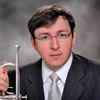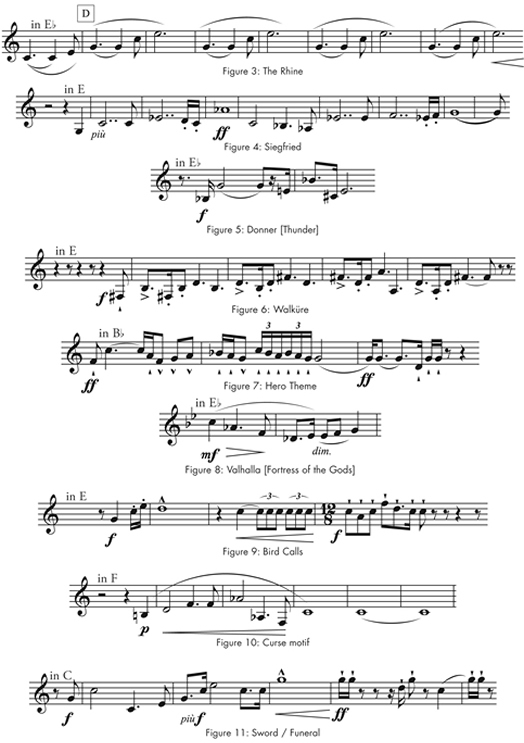Allegro
One act down, four hours to go
Perspectives from the pit of Wagner's ring cycle
Volume 113, No. 8September, 2013

David Krauss
Performing Richard Wagner’s “Der Ring des Nibelungen” is a unique experience. Fanatics fly in from all over the world to settle into the Metropolitan opera house for nearly a week to hear “Das Rheingold,” “Die Walküre,” “Siegfried” and “Götterdämmerung.” Night after night, you tend to recognize familiar faces sitting in the audience. There’s the guy in the tuxedo wearing a horned Brünnhilde helmet with the “Aren’t I clever?” look on his face, or the young couple who came all the way down from their seats high up in the family circle at intermission just to get a close-up look at an actual Wagner tuba. As for us in the pit, the daily schedule shifts to make room for a five- or six-hour performance. Dinners at home become shortened or skipped altogether because of early curtain times, and time stretches so that a two-hour act is normal. Between rehearsals and four complete performance cycles, everyone at the opera house is immersed in the Ring for eight straight weeks.
When I was a kid, Wagner’s music from the Ring had the usual connotations. Elmer Fudd singing “Kill the wabbit,” the soundtracks to “Excalibur” and “Apocalypse Now,” and the vague notion that as a Jew, Wagner’s music was off limits and somewhat akin to the forbidden ham sandwich. My first true exposure to it was when I was a student at Juilliard and Jim Pandolfi, former third trumpet at the Met, got me a last-minute ticket to see “Götterdämmerung” (standing room only to a six-hour opera). This would be a vastly different experience from sneaking into the New York Philharmonic to hear whatever the big piece was after intermission. I don’t remember who sang that night and I vaguely remember the production, but I do remember that Mark Gould, Julie Landsman and David Langlitz were leading the brass section. From the opening notes to the final immolation scene, the sounds floating up from the pit made the hours fly by for me.
The music from the Ring is as rich as the story that unfolds throughout the four operas. Wagner musically represents the gods, giants, dwarfs, mermaids, and generations of heroes and lovers that make up his story through the use of leitmotifs. They musically denote an action, object, emotion, character, place or other subject mentioned in the text or presented onstage. Having done away with the traditional recitative/aria format, Wagner adopted a new “throughcomposed” style where there were no breaks at all in the music. On top of that, Wagner’s instrumental writing for the brass section was revolutionary. The golden ring that the character Alberich guards glimmers with the “Rheingold” motif played by the solo trumpet (Figure 1). Siegmund’s sword does not appear on the stage or in the text without the trumpet playing its motif (Figure 2).

In “The Perfect Wagnerite” by George Bernard Shaw, he explains: “To be able to follow the music of The Ring, all that is necessary is to become familiar enough with the brief musical phrases out of which it is built to recognize them and attach a certain definite significance to them, exactly as any ordinary Englishman recognizes and attaches a definite significance to the opening bars of ‘God Save the King.’ There is no difficulty here: every soldier is expected to learn and distinguish between different bugle calls and trumpet calls; and anyone who can do this can learn and distinguish between the representative themes or ‘leading motives’ (Leitmotifs) of The Ring.”
Indeed, the entire story can be pieced together by following the trumpet part alone. Here are some more examples of Wagner’s leitmotifs as they appear in the first trumpet part:

The leitmotifs themselves are short and simple to play when isolated, but combined with the dramatic element and the time associated with it, new challenges arrive. For example, the first trumpet part to “Die Walküre” opens with two lines of music followed by a 45-minute tacet. During the interim, the plot unfolds onstage followed by a crucial trumpet solo motive. Fleeing for his life, Siegmund seeks refuge in a house belonging to Sieglinde and Hunding. Hunding happens to be one of Siegmund’s pursuers and tells Siegmund that when he returns in the morning the two of them will cross swords. Once alone with Sieglinde, Siegmund laments his misfortune, recalling his father’s promise that he would find a sword in direst need. Siegmund and Sieglinde fall in love, discover they are twins, and the audience realizes that their father (Wotan) has brought the twins together to achieve his ultimate plan of attaining the ring and ultimate power. It’s basically the entire plot of all three original “Star Wars” movies together in one scene. At the climax of the act, Siegmund calls out the human name of his father and discovers a sword plunged into a tree. It is at this moment where the trumpet plays the sword motive. With 45 minutes to stare at seven simple notes, many things can (and often do) go through my head. “My horn is cold. I should push in. Did I push in too much? My head hurts. How do you get the water out of a rotary trumpet anyway? Remember that time the second valve stuck? What key am I in?” As the music slowly draws closer to the solo, the intensity builds and string tremolos rage as he cries out “Walse! Walse! Where is your sword?” – then it’s my turn to play.
It’s easy for me to get paralyzed with negativity (a trait I possess in abundance). The key is to focus on the variables within my control. I try to push all the worrisome thoughts out of my head by relaxing and maintaining slow deep breaths. I constantly have to fight the urge to fidget with my horn and focus on counting bars and listening to the music. If I am in shape and prepared, everything else will take care of itself.
In addition to using the brass section as a thematic vehicle, Wagner re-invented the instruments themselves as well as the theatre they were played in. The Bayreuth Festspielhaus was designed with many theatrical advantages in mind. One of them was the unique placement of the orchestra. In this excerpt, Shaw shares his critique of Ring performances at Bayreuth: “Bayreuth performances will deserve their reputation. The band is placed out of sight of the audience, with the more formidable instruments beneath the stage, so that the singers have not to sing through the brass. The effect is quite perfect.”
The Wagner tuba was designed to fill the gap in sound between the trombones and the French horns. Similarly, the bass trumpet and contrabass trombone were modified to bridge the voids from trumpet all the way down to the tuba. Since Wagner went through such thorough efforts to create a homogeneous sound in the brass section, it is important for us as trumpet players to examine our role in the context of what Wagner thought an opera orchestra should sound like with great care.
In 2007, I was driving up to Boston from Manhattan to visit friends. Just past Hartford, there is a New York-style deli just off I-84. While I was waiting in line for my name to be called after placing my order for pastrami on rye to go, I heard the guy behind the counter yell “Daniel B… Daniel B…” Standing right in from of me in line for pastrami was Daniel Barenboim. I introduced myself and we talked about how he was coming to the Met to conduct “Tristan und Isolde” during the 2008-2009 season. He asked right away, “Will you use German trumpets?” Politely, I explained that traditionally we only use them on Mozart operas and “Fidelio.” “But what about ‘Parsifal’? Why don’t you use them for ‘Parsifal’?” he questioned. “Because I like to hit some of the notes,” I replied. A smile came and went on his face and then he rather sternly said, “But when I come for ‘Tristan,’ you will use them, yes?” My reply, “Yes, Maestro, for you we’ll play them.”
I always thought the use of rotary trumpets was mostly for show. Conductors see them and think that they hear a different sound, a “German” sound. For the most part, my rotary trumpet stayed in my locker except for Mozart, Beethoven and Brahms. Everything else was naturally played on my piston instruments. The following season when Lorin Maazel came to conduct “Die Walküre,” I figured this would be a good time to get the horns out before “Tristan” with Barenboim. After the initial awkwardness of playing difficult music on a foreign instrument, the advantages became apparent. The sound stays warm and covered from pianissimo dynamics to forte, and the clarity of attacks is obscured. The absence of brilliance (at the required dynamic levels) makes blending with the horn section effortless and natural. Like the French horn, from forte and above, the tone lights up quickly and at fortissimo in the higher register, it’s possible to play with a white-hot sound. In retrospect, when playing a piston trumpet, I played softer than Wagner’s printed dynamics most of the time in order to achieve the right balance. The rotary trumpet’s inherent tonal tendencies are a much better match for playing Wagner.
No matter what instrument I play and despite any obstacles I may face in performance, the Ring is always an enjoyable experience. Most performances end with a beer or two across the street with colleagues and friends. Since Ring cycles are programmed every three or four years, each time we start it feels fresh and by the end of it, I can’t stomach one more note.
Like any great work of art, it changes relative to your own experience. The last page of the Met’s first trumpet part to “Die Walküre” has handwritten lists of performances started by former principal trumpeters Jacob Hager, Edwin Franko Goldman and Isidor Blank. The list documents performances of “Walküre” going back to 1901 with such legendary conductors as Gustav Mahler, Arthur Bodansky and Arturo Toscanini. I felt a great sense of history when I signed my name at the bottom of the page after my first performance in 2002 (led by James Levine). When Goldman played this very part just 18 years after Wagner’s death, the profound nature of playing his music as contemporary must have had a tremendous impact on him. Even more than a century later, “Der Ring des Nibelungen” stands alone as the most ambitious and most profound work ever created for the theatre. Though the trumpet part is of relatively small consequence in the epic scale of the work, its role is vital to the story and its voice is a prominent color in the score. From my vantage point in the pit, it’s wonderful to see the impact of the trumpet part both on the stage and in the audience.
David Krauss is principal trumpet of the Metropolitan Opera Orchestra. This article first appeared in the June 2009 issue of the International Trumpet Guild Journal and is reprinted here with the permission of ITG. Thanks to Robert Sutherland, chief librarian of the Metropolitan Opera, with formatting the leitmotifs. For more on the letimotifs, see www.bitly.com/leitmotifs.
